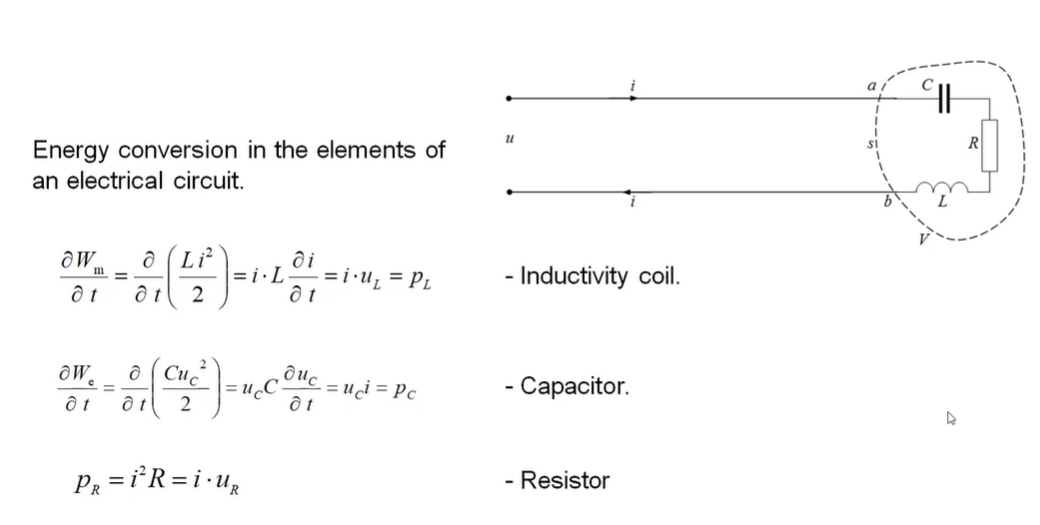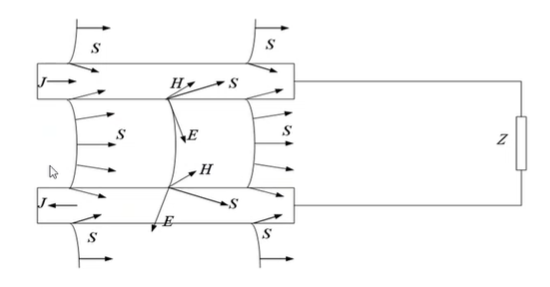
- •Лекция 1. Fundamental concepts of electromagnetics. Electrostatics. (Начало электростатики)
- •Vectors and scalar fields. (Векторные и скалярные поля)
- •Electrostatic field. (Электростатическое поле)
- •Coulomb’s Law. (Закон Кулона)
- •Electric Field Strength e and Displacement Field d. (Напряжённость и смещение электрического поля)
- •Gauss’ Law. (Закон Гаусса)
- •Electric Potential. (Электрический потенциал)
- •Work in the electric field. (Работа в электрическом поле)
- •Dielectric polarization. (Диэлектрическая поляризация)
- •Dielectric material characteristics. (Характеристики диэлектриков)
- •Properties of dielectric materials. (Свойства диэлектрических материалов)
- •Poisson’s and Laplace’ s equations. (Уравнения Пуассона и Лапласа)
- •Лекция 2. Boundary conditions for the Laplace or Poisson equations (Граничные уравнения для уравнений Лапласа и Пуассона)
- •Electrostatic Energy (Электростатическая энергия)
- •Virtual experiment. (Эксперимент по нахождению энергии системы)
- •Consequences (Следствия)
- •Continuity Equation (Уравнение непрерывности)
- •Лекция 3. Static magnetic field (Статическое магнитное поле)
- •Variables and units (Переменные и единицы измерения)
- •Main Relations (Основные соотношения)
- •Magnetic flux density (Индукция магнитного поля)
- •Biot-Savart’s law (Закон Био-Савара)
- •Ampere’s law (Закон полного тока)
- •Scalar magnetic potential (Скалярный магнитный потенциал)
- •The cut in the space (Разрез в пространстве)
- •Laplace equation for the scalar magnetic potential (Уравнение Лапласа для скалярного магнитного потенциала)
- •Vector magnetic potential (Векторный магнитный потенциал)
- •Magnetic flux (Магнитный поток)
- •Differential equation for the vector magnetic potential (Дифференциальное уравнение для векторного магнитного потенциала)
- •Gauging of the vector magnetic potential (Калибровка векторного магнитного потенциала)
- •Integral presentation of the vector magnetic potential (Интегральное представление векторного потенциала)
- •Inductance (Индуктивность)
- •Mutual inductance (Взаимная индуктивность)
- •Inductance of thin contours (Индуктивность тонких контуров)
- •Field intensity inside a cylindrical conductor (Напряжённость поля внутри цилиндрического проводника)
- •Лекция 4. Method of images (метод зеркальных изображений)
- •Equivalent charge density (эквивалентная плотность заряда)
- •Method of images for cylindrical boundaries between dielectrics (метод изображений цилиндрических границ между диэлектриками) Problem formulation (постановка задачи)
- •The inverse point (обратная точка)
- •Normal component of the field intensity (нормальная составляющая напряжённости поля)
- •Geometrical relations (геометрические соотношения)
- •Angles (углы)
- •Field induced by the line sources (поле, индуцированное линейными источниками)
- •The field sources for the external domain (источники полей для внешней области)
- •The field sources for the internal domain (источники полей для внутренней области)
- •Image method for the flat boundary between magnetic media (Метод изображений для плоской границы между магнитными носителями)
- •Equivalent magnetic charge density (Эквивалентная плотность магнитного заряда)
- •Dependence of the field intensity on the coordinate (Зависимость напряжённости поля от координаты)
- •Inductance of the two-wire transmission line per unit length (Индуктивность двухпроводной линии передачи на единицу длины)
- •Total inductance (Общая индуктивность)
- •Forces. The first line. (Силы. 1ая линия)
- •Forces. The second line. (Силы. 2ая линия)
- •Лекция 5. Solution of Laplace’s equation by separation of variables. (Решение уравнения Лапласа методом разделения переменных) Application of Laplace’s equation (Применение уравнения Лапласа).
- •Choice of a coordinate system (Выбор системы координат)
- •Variable separation in cylindrical coordinates (Разделение переменных в цилиндрических координатах)
- •Angular function (Угловая функция)
- •Radial function (Радиальная функция)
- •General solution of the Laplace’s equation in a cylindrical coordinate system (Общее решение уравнения Лапласа в цилиндрической системе координат)
- •Application of the variable separation method for the magnetic field modeling (Применение метода разделения переменных для моделирования магнитного поля)
- •Reduced scalar magnetic potential (Редуцированный скалярный магнитный потенциал)
- •Combination of scalar magnetic potential and reduced magnetic potential (Комбинация скалярного магнитного потенциала и редуцированного магнитного потенциала)
- •The scalar potential induced by the current line (Скалярный потенциал, индуцируемый линией тока)
- •The current potential in the cylindrical coordinate system (Потенциал от линии с током в цилиндрической системе координат)
- •The current potential in the complex plane (Потенциал от линии с током в комплексной плоскости)
- •Expansion of the current potential in the cylindrical coordinate system (Разложение потенциала от линии с током в цилиндрической системе координат)
- •Potentials in the problem domain (Потенциалы в проблемной области)
- •Inductance of the two-wire transmission line per unit length (Индуктивность двухпроводной линии передачи на единицу длины)
- •The flux induced by the magnetized cylinder (Поток, индуцируемый намагниченным цилиндром)
- •Лекция 6. Time dependent electromagnetic fields (Зависящие от времени электрические поля)
- •Faraday’s Law (Закон электромагнитной индукции)
- •Lenz’s Law (правило Ленца)
- •Induction by a temporal change of b (Индукция за счёт временного изменения b)
- •Induction through the motion of the conductor (Индукция за счёт движения проводника)
- •Induction by simultaneous temporal change of b and motion of the conductor (Индукция одновременным изменением во времени b и движением проводника)
- •Unipolar generator (Униполярный генератор)
- •Hering’s paradox (Парадокс Геринга)
- •Periodic electromagnetic field in the conductors. (Периодическое электромагнитное поле в проводниках)
- •Penetration of the electromagnetic field into a conductor. (Проникновение электромагнитного поля в проводник)
- •The skin effect. (Скин-эффект)
- •Poynting’s Theorem. (Теорема Пойнтинга) Electromagnetic Field Energy. (Энергия электромагнитного поля)
- •The rate of decrease of the electromagnetic field energy in a closed volume. (Скорость уменьшения энергии электромагнитного поля в замкнутом объёме)
- •Energy flows in the electromagnetic field (Поток энергии в электромагнитном поле)
- •Transmission of energy in a dc line (Передача энергии в линиях постоянного тока)
- •Transmission of energy in a dc line (Передача энергии в линиях постоянного тока)
- •The field picture near the wires with current (Картина поля вблизи провода с током)
- •Energy flows in static fields (Поток энергии в статических полях)
- •The momentum of the electromagnetic field (Момент электромагнитного поля)
- •The momentum of the electromagnetic field (Момент электромагнитного поля)
- •Лекция 8. Numerical Methods of the Electromagnetic Field Modeling. (Численные методы моделирования электромагнитного поля) Classification of the numerical methods (Классификация численных методов)
- •Classification of the problems (Классификация проблем)
- •Classification of the methods (Классификация методов)
- •Method of moments (Метод моментов)
- •Discretization of the problem domain (Дискретизация проблемной области)
- •Algebraic equation system (Алгебраическая система уравнений)
- •Finite element method (Метод конечных элементов)
- •Discretization (Дискретизация)
- •Finite functions (Ограниченная функция – отлична от нуля только в пределах треугольника)
- •Approximation of functions inside triangles (Аппроксимация функций внутри треугольника)
- •Approximation of the equation (Аппроксимация уравнения)
- •Weighted residual method (метод взвешенных невязок)
- •Galerkin method (метод Бубнова-Галеркина)
- •Weak formulation (ослабленная формулировка)
- •First type boundary conditions (Первый тип граничных условий)
- •The potential and field intensity (Потенциал и напряжённость поля)
Transmission of energy in a dc line (Передача энергии в линиях постоянного тока)

Similar consideration may be made for the load which consists of resistor, capacitor, and inductance. We should simply split the total energy which crosses this surface into several parts.
First of them, ∂Wm/∂t, the energy of the magnetic field which crosses this area corresponds to the magnetic field which is induced by inductance and is equal to
 .
.
In any time moment, this power should not be equal to zero, but if the inductivity coil is ideal, of course, this power integrated, for example, by period will be equal to zero in any case.
A similar consideration can be done for the capacitor. Finally, we shall come to the same conclusion – it’s equal to the power which correspond to the capacitor.
And from the previous consideration we can also conclude that power in the resistor which is dissipated here is equal to such a product.
Now, this energy comes to the load from the external electromagnetic field and may be expressed as integral over the surface from E cross H, ds.

It is ∂W/∂t and then plus the energy which is dissipated in resistors. The energy ∂W/∂t is dependence of the energy stored in the inductance and capacitor and it is equal i·uL+i·uC and also i·uR. We can transform this to i times sum of these voltages. It is power. Again, we can find out that energy that crosses this area is equal to the power, which now is not dissipation of the energy but the power of the energy transformation (into the heat, electric field, magnetic field). The power of the flow of electromagnetic energy entering the surface S is equal to the total power consumed in the circuit between ab terminals.
The field picture near the wires with current (Картина поля вблизи провода с током)
That’s the general picture which corresponds to the transmission line with arbitrary load. Due to the presence of a small tangential component of the electric field strength vector at the surface of the conductor with current, the resulting electric field strength vector E is not perpendicular to the surface of the conductor. This leads to the appearance of the normal component of the Poynting vector at the surface of the conductor. Consequently part of the transmitted energy is absorb inside the wires of the transmission line.

There are two wires which carry current to the load and from the load. Certainly, there should be a voltage between these two wires that’s why that’s a line which shows the electric field in the space around these wires. The normal component of the electric field corresponds to the voltage between wires that’s the voltage as if two lines form a capacitor. But also, there is a horizontal component which corresponds to the Ohm's Law, in such a case the Poynting’s vector will come just inside the wire, partly, the energy is transformed from the source to the load, and the horizontal part of the Poynting’s vector just illustrate this energy, transformed from the source to the load. But the small vertical component of the Poynting’s vector illustrates the power, which is dissipated in non-ideal wires. If the wires are ideal than there should not be component of the Poynting’s vector which will come inside the wire. All these S-vectors will be parallel to the wire surface. H here in any case is induced by the current inside wire and the H-field, magnetic field, circulates around the wires, H-vector has no component which is directed from the power source to the load, this vector is always normal to our surface.
